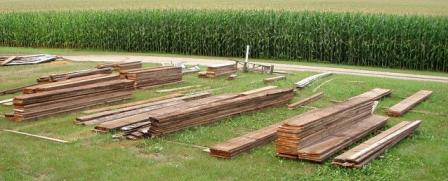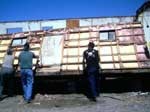Best Practices for Reducing, Reusing, and Recycling Construction and Demolition Materials
Builders, construction teams and design practitioners can divert construction and demolition (C&D) materials from disposal by buying used and recycled products, practicing source reduction, preserving existing structures, as well as salvaging and reusing existing materials.
On this page:
- Designing for Adaptability, Disassembly and Reuse
- Deconstructing Buildings
- Environmental Considerations
- Where to Buy or Take Recovered Materials and Products
Designing for Adaptability, Disassembly and Reuse
Designing a building to support adaptation, disassembly and reuse can reduce waste and extend its useful life, providing economic and environmental benefits for builders, owners, and occupants, and the communities. This practice can also avoid building removal altogether, and allows materials to be easily, cost-effectively and rapidly taken apart and directed for further reuse. By designing for adaptability, disassembly and reuse, design practitioners are finding new opportunities early in the design process to reduce environmental impacts, conserve resources, and reduce costs.
Some strategies to use when designing for adaptability, disassembly and reuse include:
- Developing an adaptation or disassembly plan with key information (e.g., as built drawings, materials, key components, structural properties and repair access and contact information).
- Using simple open-span structural systems and standard size, modular building components and assemblies.
- Using durable materials that are worth recovering for reuse and/or recycling.
- Minimizing the use of different types of materials and making connections visible and accessible.
- Using mechanical fasteners such as bolts, screws and nails instead of sealants and adhesives.
- Planning for the movement and safety of workers to allow for safe building adaptation, repair and disassembly.
For more information on putting these strategies into practice, see EPA's fact sheets and the Design for Disassembly in the Built Environment: A Guide to Closed Loop Design and Building (PDF).(69 pp, 1,010 K, About PDF)Exit
Deconstructing Buildings
Disposal of C&D materials wastes resources and landfill space and results in pollution when new building materials are manufactured in their place. Deconstruction can be applied on a number of levels to salvage usable materials and significantly cut waste and reduce disposal. This can range from reusing an entire structure or foundation, to select assemblies and systems, to the careful removal of specific materials or items for reuse.
 Wood salvaged during deconstruction can be used for other projects. Image courtesy of: Dan Oswald, and Iowa Central Community College.
Wood salvaged during deconstruction can be used for other projects. Image courtesy of: Dan Oswald, and Iowa Central Community College.
While complete deconstruction is the preferred and most sustainable method for removing or renovating a structure, it is not always possible due to the type of building and/or its components. According to the Department of Housing and Urban Development, highly deconstructable buildings:
- Are wood-framed. Wood-framed buildings, especially those with heavy timbers and beams or with unique woods such as Douglas fir, American chestnut, and old growth southern yellow pine, have “stick-by-stick” construction that lends easily to the deconstruction process. These kinds of lumber also have highly versatile reuses.
- Contain specialty materials with high resale value. These include items such as hardwood flooring, multi-paned windows, architectural moldings, and unique doors or plumbing/electrical material fixtures.
- Have high-quality brick-laid construction with low-quality mortar. This construction allows for relatively easy break-up and cleaning.
- Are structurally sound. Buildings with less rotted and decayed materials maximize the potential for deconstruction.
For buildings that do not meet one or more of these criteria, partial deconstruction is an excellent option. In these cases, a combination of deconstruction and demolition can be used.
EPA’s Deconstruction Rapid Assessment Tool assists in prioritizing structures for deconstruction and salvage, and allows managers to make critical decisions in allocating time and resources. For some examples of specific items that tend to carry reuse value and make good candidates for salvage, see Reuse and Recycling Opportunities and Demolition.
Abandoned Mobile Homes Toolkit
 An abandoned mobile home being deconstructed.Mobile homes can be one of the easier forms of housing to buy and install. However, these structures do not have a long lifespan. When residents move, they often abandon mobile homes to decay.
An abandoned mobile home being deconstructed.Mobile homes can be one of the easier forms of housing to buy and install. However, these structures do not have a long lifespan. When residents move, they often abandon mobile homes to decay.
Once abandoned, these homes present the following economic, environmental, and safety issues to the community:
- Decreasing aesthetics as they continue to deteriorate, devaluing surrounding properties;
- Providing unsafe places for children to play;
- Introducing infestations of vermin and other disease vectors;
- Encouraging gatherings for consumption of drugs/alcohol; and
- Encouraging illegal dumping, often hidden within the walls of the unit.
EPA has prepared an Abandoned Mobile Homes Toolkit to demonstrate the recovery of the many valuable resources typically contained within an abandoned unit. The toolkit includes videos that demonstrate the step-by-step process for mobile home deconstruction, a reconstruction project demonstration using recovered resources as well as a best management practices document, assessment guide, and additional resources.
Environmental Considerations
While many C&D materials can find appropriate uses, it is important to note that a small percentage contains constituents of potential concern that can be harmful to human health and the environment if improperly managed. For many of these constituents, protective federal regulations or guidance are in place to prevent or restrict the use of the material or to recommend best management practices.
For example, asbestos, polychlorinated biphenyls (PCBs) and lead, are federally regulated. A party managing C&D materials with these, or other federally-regulated constituents, must meet the requirements and standards of all applicable federal regulations. For examples of potentially harmful C&D materials that can be encountered in residential buildings, please see EPA’s Harmful Materials and Residential Demolition web page.
Many states and local governments also have established their own requirements for harmful constituents in C&D materials. Check with your state program for information on local jurisdiction-specific requirements.
Where to Buy or Take Recovered Materials and Products
The current market for salvaged or reusable materials is comprised of outlets that differ in the size of operations, the type of materials being sold and the degree to which materials are modified or prepared for sale. Reuse centers represent a small percentage of the total number of reuse retail businesses, but manage the largest volumes of materials, primarily offering items such as doors, windows, cabinets, plumbing fixtures, lumber, millwork, metals, flooring, hardware, bricks, and fencing, but also including used goods such as architectural salvage, furniture, appliances, and lighting fixtures. Reuse stores carry smaller amounts of materials that are typically higher-value items, such as used furniture and antique fixtures.
Materials and waste exchanges are markets for buying and selling reusable and recyclable commodities. Some are physical warehouses that advertise available commodities through printed catalogs, while others are simply websites that connect buyers and sellers. Some are coordinated by state and local governments; others are wholly private, for-profit businesses. The exchanges also vary in terms of area of service and the types of commodities exchanged. In general, waste exchanges tend to handle hazardous materials and industrial process waste while materials exchanges handle nonhazardous items.
You can find more guidance on purchasing recycled C&D materials by visiting EPA’s Comprehensive Procurement Guidelines website. For resources to begin salvaging and reusing C&D materials, start with a list of organizations working to reduce the disposal of construction and demolition materials.

